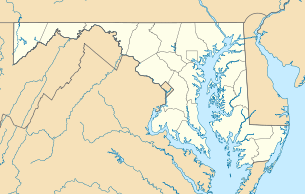Fort Washington Park
| Fort Washington Park | |
|---|---|
 | |
| Location | Prince George's County, Maryland, U.S. |
| Nearest city | Fort Washington, Maryland, U.S. |
| Coordinates | 38°42′39″N 77°01′59″W / 38.71083°N 77.03306°WCoordinates: 38°42′39″N 77°01′59″W / 38.71083°N 77.03306°W |
| Visitors | 306,802 (in 2005) |
| Governing body | National Park Service |
Fort Washington, located near the community of Fort Washington, Maryland, USA, was for many decades the only defensive fort protecting Washington D.C. The original fort, overlooking the Potomac River, was completed in 1809, and was named Fort Warburton. During the War of 1812, the fort was destroyed by its own garrison during a British advance. The current historic fort — maintained by the National Park Service — was initially constructed in 1824. It is a stone structure with a good cannon shot down the Potomac River. The fort was extensively remodeled in the 1840s and 1890s. The Fort was turned over to the U.S. Department of the Interior in 1946 after its last military personnel departed.
The expansive grounds of the present Fort Washington Park, with its extensive hiking/bicycle paths and river view, are a scenic venue for picnicking, fishing, and outdoor recreation. Historical re-enactments are held periodically at the Fort, and there is a small museum. In 2006, repairs were done to shore up the crumbling outer wall, in preparation for the 200th anniversary.
The Fort Washington Light, located below the fort, was established in 1857. The current tower, standing 28 feet tall, was constructed in 1882.
History



1808 to 1871
Construction on first Fort Washington, then called Fort Warburton, was completed on December 1, 1809. In August 1814, with British forces in Washington (having marched overland) and British ships heading up the Potomac, the fort was destroyed by its own garrison to prevent it from being captured and occupied by the British.
Twelve days after the destruction of the fort, James Monroe, the acting Secretary of War, hired Major Pierre L’Enfant to construct new defenses. In November 1814, Monroe questioned L'Enfant actions, asking for less spending. On July 14, 1815, work was halted. Two months later, L'Enfant was replaced by Lieutenant Colonel Walker Keith Armistead of the U.S. Army Corps of Engineers. The fort was completed on October 2, 1824, at a total cost of $426,000, excluding armament, which had not yet been installed.
Extensive remodeling was performed in the 1840s and the first guns were mounted in 1846. The masonry fort was occupied by soldiers from the First, Third and Fourth U.S. Artillery during its early history. Except for a few guns at the Washington Arsenal, Fort Washington was the only defense for the nation’s capital until the Civil War when a circle of temporary forts was built around the city. Battery Rogers and Fort Foote were the only seacoast forts in the system and armed with large Rodman and Parrott cannons. Fort Washington was garrisoned as the outer defense for the city. Companies of the First and Fourth Artillery as well as numerous state artillery units passed through the post during the war.
1872 to 1916
In 1872 the garrison was removed and additional property purchased to construct a new defense system. Between 1873 and 1875, four 15-inch Rodman guns and a magazine were partially constructed. In 1875, funds for the project was withdrawn and the post was abandoned until 1891.
In 1886, a new defense system, consisting of rifled steel guns in concrete emplacements was authorized, and work began at Fort Washington in 1891. The next year ground was broken for Battery B, later named Battery Decatur, and the guns were mounted in 1896. Eventually eight concrete batteries at Fort Washington and four at Fort Hunt made up the Potomac Defense Command. In the years prior to World War I, Fort Washington was downgraded to harbor defense and the large guns removed.
1917 to 1940
During World War I, the post was used as a staging area for troops being sent to France. The 8th Provisional Artillery Battalion was organized at the post and sent to France where they became the 53rd Railroad Artillery Regiment. After the war the 3rd Battalion 12th Infantry moved in and became the ceremonial unit for the Military District of Washington.
In 1939 the post was abandoned and turned over to the U.S. Department of the Interior; the plan was use it as a terminal point for a bridge across the Potomac River and a parkway to be built along the shore. A barracks for the Civilian Conservation Corps was built that year on the post.
1941 to present
When the United States entered World War II in late 1941, Fort Washington was returned to the army and became the home of the U.S. Army Adjutant General’s School. After the war ended, in 1945, the Veterans Administration managed the post hospital and other government agencies occupied some of the buildings. In 1946 the fort was returned to the Department of the Interior. Many of the buildings built between the two world wars were removed. Since 1946, the post has been a park, now run by the National Park Service.
External links
- Official website
- Fort Washington is part of the Chesapeake Bay Gateways and Watertrails Network
- Maryland Historical Trust
- HABS No. MD-307-A, "Fort Washington, Main Gate, Fort Washington Road, Fort Washington Forest vicinity, Prince George's County, MD", 20 photos, 3 photo caption pages
- HABS No. MD-307-B, "Fort Washington, Officer's Quarters", 8 photos, 1 photo caption page
- HABS No. MD-307-C, "Fort Washington, Barracks", 1 photo, 1 photo caption page
- HABS No. MD-307-D, "Fort Washington, Fort", 60 photos, 27 measured drawings, 7 photo caption pages
- HABS No. MD-307-E, "Fort Washington, Commandant's House", 5 photos, 1 photo caption page
- HABS No. MD-307-F, "Fort Washington, Powder Magazine No. 1", 1 measured drawing, supplemental material
- Northern Virginia’s Role in the War of 1812
| ||||||||||||||||||||||||||||||||||
| |||||||||||||||||||||||||

